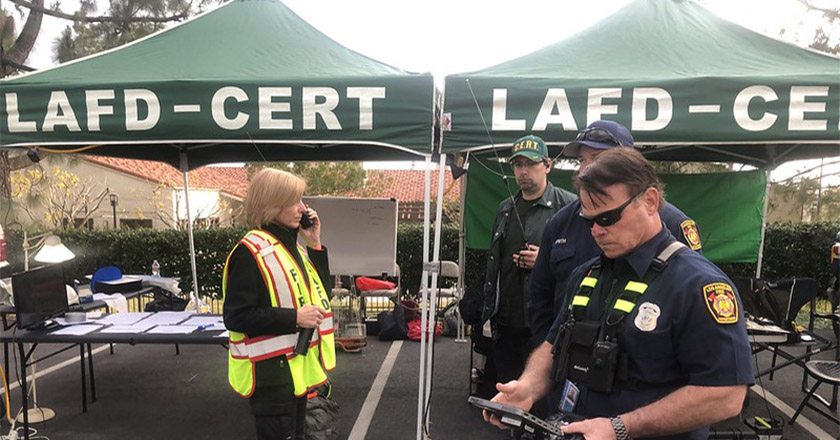In times of crisis, we’re used to the brave men and women who have dedicated their lives to becoming first responders coming to our aid. They don their fire gear or their police vests, grab their paramedic equipment, and race towards disaster without a moment’s hesitation.
But can you imagine your neighbors doing the same? What about your child’s teacher or your mail person? What about you?
It may seem unrealistic, but the truth is that normal citizens with nothing but the desire to make a change and help people can become responders in times of crisis. The Community Emergency Response Team (CERT) makes this a reality.
CERT is a volunteer organization that aims to teach citizens about emergency preparedness. The goal is for CERT members to be familiar with how to respond to risks specific to their area. Volunteers are trained in disaster response skills, such as light search and rescue, first-aid, and fire safety.
CERT is not only a way for civilians to get involved and support their communities during a crisis event, but it’s also a way for municipalities to supplement their response efforts. There are technological applications available that can help support the maintenance of CERT programs and help things run smoothly as well.
History and Training
CERT was founded in 1985 by the Los Angeles City Fire Department. The Department saw a need for civilian help to meet their disaster response needs, which was confirmed when the Whittier Narrows earthquake hit in 1987.
Since then, CERT has grown nationwide. According to ready.gov, every state in the U.S., including tribal nations and territories, has a CERT program. Within these areas, there are more than 2,700 local CERT programs and over 600,000 individual volunteers. Teen CERT classes are also now available.
The CERT training constitutes of eight two hour courses that cover the following topics: disaster preparedness, fire suppression, medical operations I and II, light search and rescue operations, psychology and team operations, and course review and disaster simulation. Jurisdictions may also add items that are relevant to their specific community and hazards.
How Governments Use CERT
CERT is officially run through an emergency management or government agency, but there are other volunteer groups, such as The Red Cross, Southern Baptists, and other VOAD groups (Volunteer Organizations Active in Disaster), that are independent entities. Some jurisdictions don’t call their groups CERT. Their volunteer programs have different names, such as Neighbors Helping Neighbors, but they have similar functions and goals.
Municipalities use their CERT teams in a variety of ways. Some of the main tasks and responsibilities of CERT teams include emergency preparedness training with local communities, assisting with damage assessment, acting as shelter staff, helping with the Radio Amateur Civil Emergency Service (RACES), and handing out food and supplies.
The tasks assigned to CERT volunteers depend largely on the situation and the phase of the disaster. Volunteers are trained to do more than what they actually do, as you can see from the CERT course curriculum outlined above. If need be, CERT volunteers can respond in a more directed way.
Governments typically call upon their CERT volunteers for weather events, namely earthquakes, flooding and hurricanes, because they are the most common types of incidents that can overwhelm resources. Free support from the public is appreciated in times of hardship and can really make a difference in the quality of response.
Technology to Manage CERT
Technology platforms are available to assist with the development and maintenance of CERT programs. As your program grows—from managing and tracking volunteers through sign-up and training, to active participation and deployment—can become unwieldy.
Operational software platforms can create workflows, forms, and tasks to easily regulate all aspects of the volunteer process. They can also facilitate secure communication with volunteers either during an incident or on a daily basis.
Volunteers can also complete damage assessments in the field with the aid of virtual maps and digital forms. They can attach images of the damage directly into the form for reference. Additionally, plans can be launched directly from these technology platforms so your CERT team is ready to go when disaster strikes.
Taking your CERT program digital is highly beneficial for both volunteers and managers. It makes it easy to communicate effectively about activations, exercise dates, and planned events. You also have a log of volunteer information securely located in one place.
Additionally, digitizing your CERT program means that data collected by volunteers out in the field won’t be lost. They can input information in the form of text, photos, videos, etc. directly into an iPad or mobile devices, and the system will log it automatically.
The Benefits of CERT
CERT not only provides a way for average citizens to get involved in their communities and give back in times of crisis, but it allows jurisdictions to supplement their response efforts with a no-cost alternative.
Getting involved in CERT is a way to immerse yourself in your community and make a difference. Learn more about your local CERT program here and get involved today! You’ll be glad you did.








